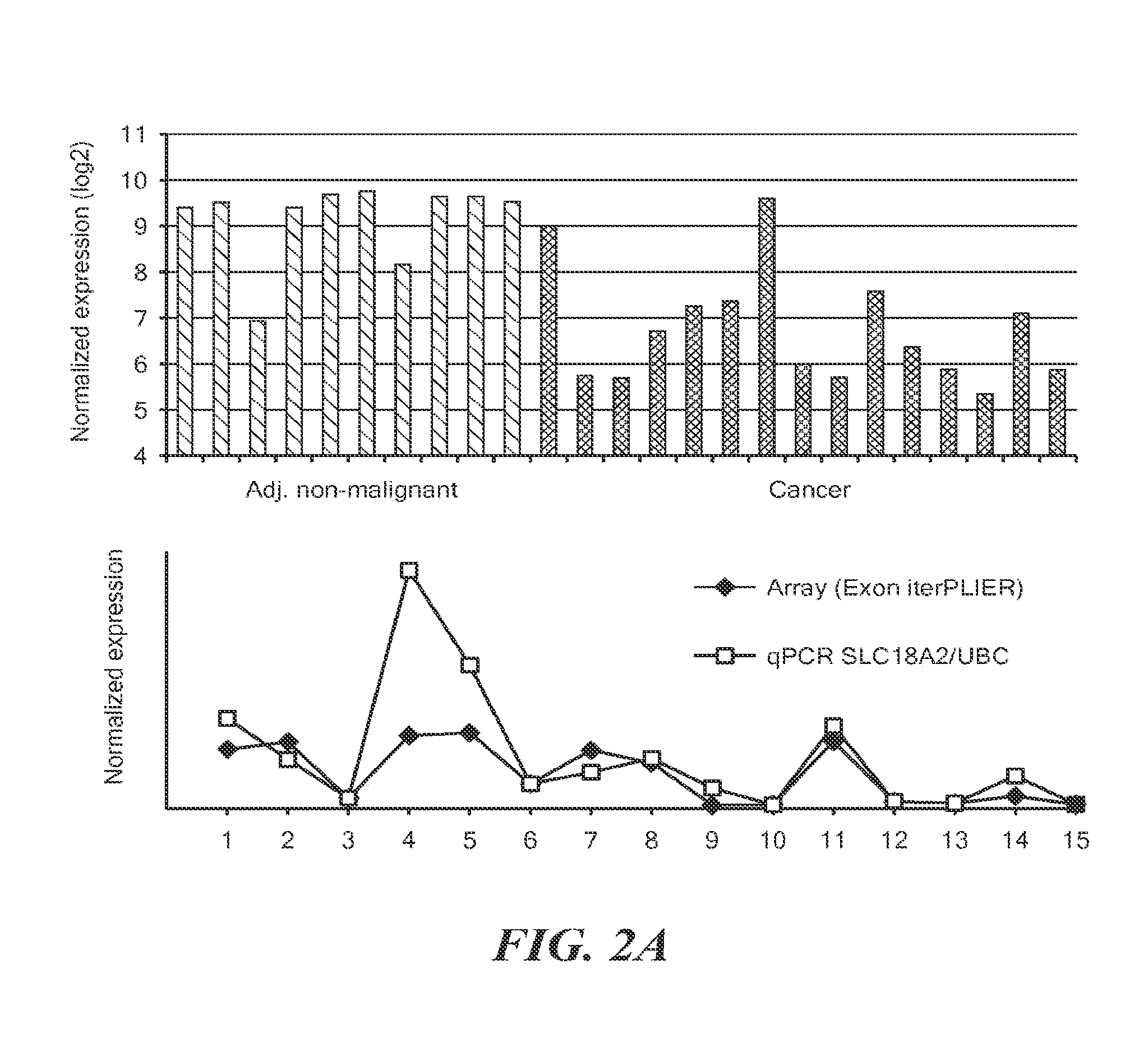Marker of Prostate Cancer
a prostate cancer and gene technology, applied in the field of slc18a2 gene as a marker of prostate cancer, can solve the problems of cancer morbidity and mortality, needle biopsy may fail to identify even significant amounts of cancer, and the adenocarcinoma of the prostate, and achieve the effect of increasing the transcriptional and/or translational expression level of the slc18a2 gen
- Summary
- Abstract
- Description
- Claims
- Application Information
AI Technical Summary
Benefits of technology
Problems solved by technology
Method used
Image
Examples
example 1
Identification of Novel Candidate Markers of Prostate Cancer
Candidate Gene Selection
[0389]To identify novel candidate genes downregulated in prostate cancer, we re-analyzed microarray expression profiling (20) and SNP array (31) data sets generated earlier in our group. FIG. 1 lists the top 20 most significantly downregulated genes in prostate cancer versus adjacent non-malignant prostate tissue samples based on Affymetrix Exon Array analysis. Most of these genes have also been found downregulated in prostate cancer by traditional 3′ array analysis, confirming the usefulness of exon arrays for transcript level expression analysis. Two novel downregulated genes were identified: DCHS2 and VIT. Three of the 20 genes were located at common (>20%) LOH regions mapped by Affymetrix 50K SNP array analysis: CTSB at 8p22 (50% LOH), ALOX15B at 17p13.1 (23% LOH), and SLC18A2 at 10q25 (23% LOH), indicating that these genes are selectively lost in prostate cancer cells. Whereas possible roles in ...
example 2
SLC18A2 Protein Expression in Non-Malignant and Prostate Cancer Tissue
Tissue Microarray Analysis
[0390]SLC18A2 protein expression in non-malignant and prostate cancer tissue samples was investigated by immunohistochemical analysis of two tissue microarrays (TMAs) containing 738 specimens from Danish and Swiss patients with benign or malignant prostatic disease.
[0391]For immunohistochemistry, TEG buffer was used for epitope demasking TMAs were stained with a polyclonal SLC18A2 (AB1767, Chemicon) antibody diluted 1:300 in TBS buffer with 1% BSA. The anti-rabbit EnVision+System (Dakocytomation, Denmark) with HRP-labelled polymer and DAB solution (Kem-En-Tec, Denmark) was used for secondary staining. For negative controls, primary antibody was omitted. Blinded scoring for cytoplasmic and nuclear SLC18A2 immunoreactivivity (0=no; 1+=weak; 2+=moderate; 3+=strong) was performed by a trained pathologist and a scientist with extensive experience in prostate histology. In cases of disagreement...
example 3
Methylation Status of the 5′ End of SLC18A2
SLC18A2 is Hypermethylated in Prostate Cancer
[0397]Genomic bisulfite sequencing of a CpG island at the 5′ end of SLC18A2 (FIG. 5A) was used to investigate, if SLC18A2 silencing in prostate cancer cells involves DNA hypermethylation.
[0398]For bisulfite sequencing, genomic DNA from prostate cell lines and carefully selected 20-μm sections of fresh-frozen Tissue-tek-embedded BPH, adenocarcinoma and adjacent non-malignant prostate tissue samples was isolated using the PUREGENE DNA Purification Kit (Gentra Systems) with proteinase K treatment (100 units, 30 min, 37 C), as previously described (29). Laser-microdissection was performed as described in (31). DNA was bisulfite converted using the MethylEasy DNA Bisulfite Modification Kit (Human Molecular Signaling, Sydney, Australia). The SLC18A2 promoter CpG island was PCR amplified with TEMPase Hot Start DNA Polymerase (Ampliqon) using primers 5′-TTTTAGGTTTGGGTTTTTAAGGTATT-3′ (SEQ ID NO: 8) and 5′...
PUM
 Login to View More
Login to View More Abstract
Description
Claims
Application Information
 Login to View More
Login to View More - R&D
- Intellectual Property
- Life Sciences
- Materials
- Tech Scout
- Unparalleled Data Quality
- Higher Quality Content
- 60% Fewer Hallucinations
Browse by: Latest US Patents, China's latest patents, Technical Efficacy Thesaurus, Application Domain, Technology Topic, Popular Technical Reports.
© 2025 PatSnap. All rights reserved.Legal|Privacy policy|Modern Slavery Act Transparency Statement|Sitemap|About US| Contact US: help@patsnap.com



